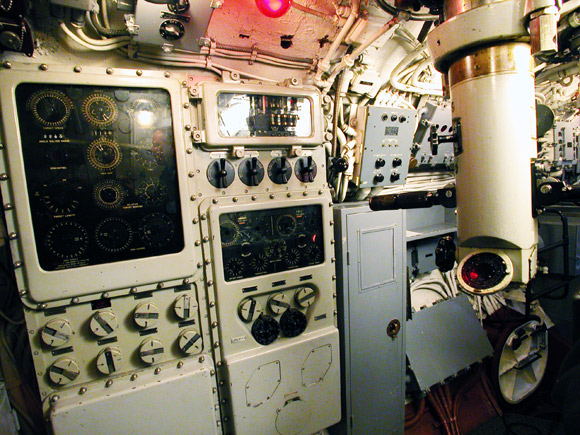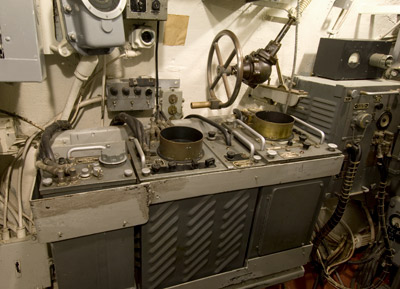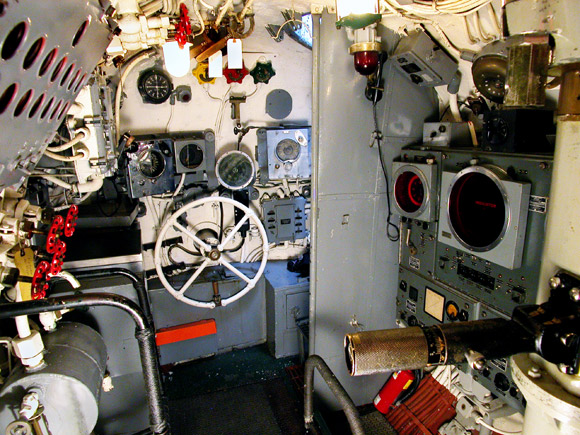|
Located above the control room, the conning tower was primarily the attack and
navigation center of the boat and the Commanding Officer's battle station.
The conning tower is the smallest compartment on the submarine, only 8
feet in diameter and 17 feet long. Tracking
a target and maneuvering into attack position could take several hours. During this time there could be
as many as ten men at their battle stations.
Consider the difficulty of aiming and firing a torpedo so it will successfully hit a target while both your ship and the target are moving. When the fire button is pressed, the torpedo is ejected by compressed air from the torpedo tube, its engine starts and it runs a safe distance from the boat before it begins a turn to its final course. It then travels straight on this course before hitting the target. All together there could be a delay of 1.5 to 15 minutes (1000 yards to 8 miles) during which any small error in calculation of the firing angle will cause the torpedo to miss the target. The World War II German and Japanese systems could compute and set the gyro angle for a fixed time in the future, but did not track the target. However, by the late 1930s, the U.S. system had perfected the fire control system to continuously supply the correct firing angle into the torpedo so it could be fired at any time.

See another view aft in the conning tower.
The heart of the system is the Torpedo Data Computer (TDC).  It is an analog computer of about 1,500 lbs. located aft and port in the conning tower. It receives input from the gyrocompass and the log to keep track of its own ship's movement. It also took input from the target bearing transmitters on the bridge, the sonar, the radar and from the crew to estimate the course, speed, bearing and distance of the enemy. It then continuously computed the firing solution and signaled the equipment in the torpedo room that set the torpedo gyro angle. This system was unique during the war and provided a significant advantage to the U.S. submarine. It is an analog computer of about 1,500 lbs. located aft and port in the conning tower. It receives input from the gyrocompass and the log to keep track of its own ship's movement. It also took input from the target bearing transmitters on the bridge, the sonar, the radar and from the crew to estimate the course, speed, bearing and distance of the enemy. It then continuously computed the firing solution and signaled the equipment in the torpedo room that set the torpedo gyro angle. This system was unique during the war and provided a significant advantage to the U.S. submarine.

Located opposite the TDC are the controls and indicators for the SJ and ST radar.  These were advanced surface search radars that allowed Pampanito to locate the enemy when on the surface. They could also be used to navigate the boat when close to shore, even through the fog. These were advanced surface search radars that allowed Pampanito to locate the enemy when on the surface. They could also be used to navigate the boat when close to shore, even through the fog.
Just forward of the TDC are the controls and indicators for the WCA sonar.  These were capable not only of listening for the sounds of the enemy, but also estimating its distance and bearing. Later in the war, the WCA sonar indicators were modified so they could display the JT sonar information as well as their own. These were capable not only of listening for the sounds of the enemy, but also estimating its distance and bearing. Later in the war, the WCA sonar indicators were modified so they could display the JT sonar information as well as their own.
The two periscopes are the eyes of the submarine and are located along the center
line of the boat. They were not only
used for attack and observation when submerged, but also for increased
lookout range and photo reconnaissance and could transmit radar on the surface. The forward
scope (#1) is larger, transmitting more light for night use and has the ST
range finding radar built in. The after scope (#2) is the attack scope and has a
much smaller profile at the top that is harder for an enemy to see during daytime attacks. It has an optical range finder to compute
the distance to the target. They are raised and lowered hydraulically. 

See another view forward in the conning tower.
Other Features in this Compartment:
Main Steering Station: Similar to the auxiliary station in the
control room, the main helm and associated instruments are located against
the forward bulkhead.
Torpedo Indicating Panels: The lights on this panel indicate
torpedo tube status and it has two red firing plungers, one for each torpedo tube group,
fore and aft.
Dead Reckoning Tracer: Identical to the unit in the control room,
the DRT is located all the way aft.
|